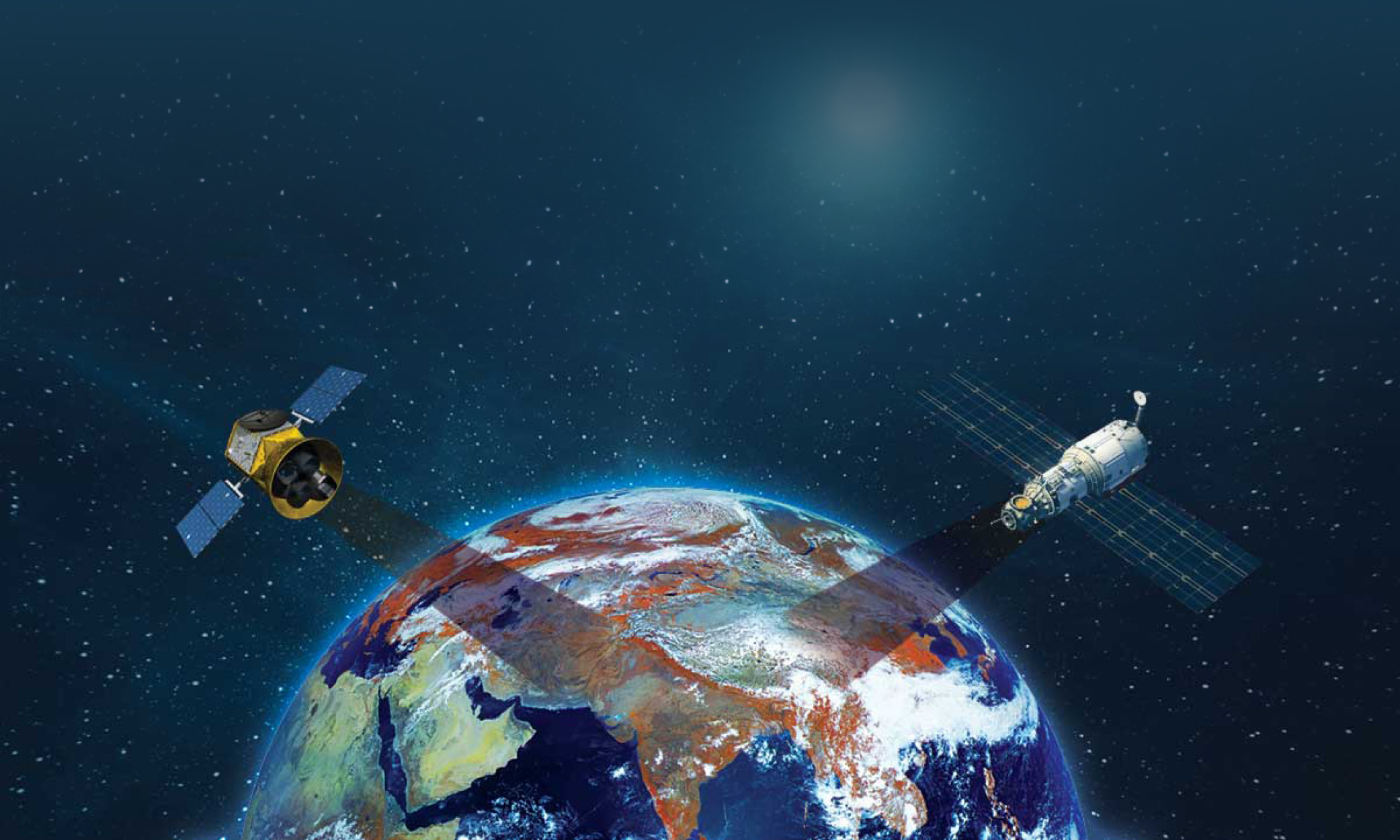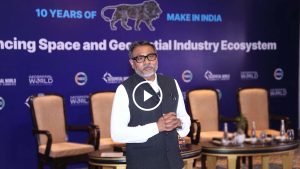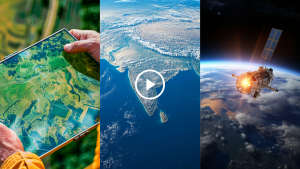Since 1950s, New Delhi and Beijing have laid emphasis on the development of space technology for a host of reasons. However, despite similarities, there have been stark contrasts in the spacing journeys of Asia’s two biggest countries.
The history of the Indian and Chinese efforts in adopting space as an element of their future growth has some common factors but many significant differences that might account for the different paths the two countries took and their achievements today.
Both countries emerged after the turbulence of World War 2. India had been fighting for independence from the colonial yoke of the British Empire, while China was engaged in a debilitating war with Japan which ended in 1945, but gave way to civil war which ceased only after the formation of the People’s Republic of China (PRC) in 1949.
Thrust for Science
Since the early years, both countries saw the need for science as an asset for development. The Chinese government’s consultative conference as well as Jawaharlal Nehru, India’s first Prime Minister, emphasized the crucial role of science for solving key issues, as well as national development.
The Beginnings
Both the UN Committee on Peaceful Uses of Outer Space and COSPAR had indicated that a sounding rocket range near the geomagnetic equator could help in studies of the equatorial electrojet.
INCOSPAR set out to locate such a site and chose a small fishing village, Thumba on the east coast of Kerala near the city of Trivandrum. By mid-1962 the decision was taken to set up the Equatorial Rocket Launching Station at Thumba.
The US was amenable to assist in setting up such a station by way of providing training in rocket preparation, launching, telemetry, telecommand and radar tracking and also the initial sounding rockets. By end of 1962 teams of engineers were sent to NASA establishments at Langley, Goddard and Wallops Islands.
On 21 November 1963, the first sounding rocket, a US Nike-Apache was prepared and launched by the team to conduct a Barium vapour experiment to observe wind speeds at altitudes between 30 to 200 Km. This facility became the Thumba Equatorial Rocket Launching Facility (TERLS) with assistance from France, USA and USSR. In February 1968, this launch facility was dedicated to the UN.
To move things forward, a Rohini Sounding Rocket Program was started to develop the technologies of propellant, guidance, etc. All the laboratories in Trivandrum were brought under a new unit called the Space Science and Technology Centre (SSTC) in 1965.
The first Rohini-75 rocket was launched in 1967. Immediately after the successful launch Dr Sarabhai spoke to his team about his wish to create a new frontier in the field of Science and Technology in India and unveiled his plans for an Indian Satellite Launch Vehicle. Sarabhai passed away on 31 December 1971.
In 1972, Department of Space was created with Satish Dhawan as its Secretary and Chair of Space Commission. He also was designated Chairman of ISRO. In 1975, ISRO became a government unit under DOS.
Noting the importance of missiles for the defense of China, the Fifth Academy was set up in 1958 at the Ministry level headed by a veteran of the People’s Liberation Army with Qian heading the technical effort. The USSR helped with the supply of missiles, consultancy and training.
By end of 1958, ten laboratories had been set up and construction began in April 1958 for the Jiuquan MissileTest facility. This would later become the launch site for China’s first satellite in 1970.
Rockets and Missiles
The USSR had launched Sputnik in 1957 and this became a lodestar for the Chinese. Qian released a plan for a Chinese satellite to be launched in January 1958 as well as development of sounding rockets as a part of the missile program. Mao was in favour of these efforts which was approved by CAS in April 1958 but deferred by Party General Secretary Deng Xiaoping in favour of the missile program.
However, the sounding rocket program continued independent of the missile program under the Shanghai Mechanical and Electronics Institute set up in 1958.
It is interesting to note that while both China and India preferred to work on sounding rockets for scientific research, China’s main thrust was on the missile program. That is not to say that India was not interested in missile development but that work was assigned to the Defence Research and Development Organisation, DRDO.
Abdul Kalam who led the ISRO team for the development of the first Satellite Launch Vehicle SLV-3 later joined DRDO as the head the Indian Guided Missile Program, IGMP.
Launch Vehicles
The Chinese launcher series which began with the CZ-1 grew rapidly to a whole family of launchers. CZ-1 was derived from the DF-4 missile by adding a solid propellant third stage to the missile. The CZ-1 series have been retired. The range now goes from CZ-2 to CZ-8 and 11. CZ-9 and 10 are under development.
Within each series there are variants for different types of payloads like satellites, manned spacecraft and space station components, to be launched into different orbits like Low Earth (LEO), Sun Synchronous (SSO) and Geostationary Transfer (GTO). The smallest series CZ-11 is a tube or sea platform launcher with a capability of 700Kg to LEO or 350 Kg to SSO. The heaviest launcher so far is the CZ-5 capable of 25,000 Kg to Leo and 14,400 Kg to GTO.
CZ-5 was used in the Mars lander cum rover mission as well in the Chang’e 5 lunar sample return mission. CZ-5B was used for launching their latest Tianhe space station core module and was used twice to launch Tianhe laboratory cabin modules. CZ-2F/G was used thrice to transport crewed modules to the Tianhe. The Chinese have a total of 468 launches to their credit. Of these 11 were failures and 7 partial failures. A success rate of 96.2% is admirable.
In India, Dr Sarabhai decided to commit INCOSPAR to a satellite launch vehicle program in 1969 and began scouting for a suitable launch site on the east coast. They settled on an island Shriharikota just off the coast of Andhra Pradesh and 100 Km north of Chennai. Also in 1969 INCOSPAR became a part of Indian National Science Academy and all its space related projects became a part of the newly formed Indian Space Research Organisation (ISRO) under DAE, to be managed by PRL.
Following Sarabhai’s demise on December 31, 1971 ISRO underwent major structural changes and became a R&D unit of the newly setup Department of Space in 1972. Simultaneously activities under the SLV project in ISRO were brought under the third variant of the possible designs being considered as SLV3 Project and A P J Abdul Kalam was designated as its Project Manager.
The SLV project was formally launched in 1972. The first SLV launch ended in failure in 1979. The second put a 40 Kg Rohini satellite in orbit in July 1980, a full decade after China’s maiden launch which put a 100 Kg satellite in orbit.
While the first Chinese satellite broadcast the song “The East is Red”, the Indian Rohini was used to monitor the performance of the fourth stage of the rocket. The SLV was retired in 1984 after two more successful launches in 1981 and 1983.
In 1972, the separate facilities like TERLS, SSTC, RFF and PFF were merged into a single unit, the Vikram Sarabhai Space Centre, VSSC. This unit and SHAR, now the Satish Dhawan Launch Centre (SDLC) became the major work centres for launcher development. Later three more facilities came up, the Liquid Propulsion Systems Centre (LPSC) at Valiamala for developing liquid fuelled rocket motors, at Mahendragiri for testing Liquid fuelled rocket motors and at Vattyurkavu for the ISRO Inertial Systems Unit (IISU). Kalam became the Director of Aerospace Dynamics and Design Group which would configure the future launch vehicles and technology development. The thrust was on four launchers, SLV3, ASLV, PSLV and GSLV. In 2012 a Small Satellite Launch Vehicle (SSLV) has been added to the range. The sounding rocket program continued as before.
In order to increase the payload capacity the Augmented SLV (ASLV) program was approved in 1982 and the first two developmental flights in 1987 and 1988 failed due to structural instability problems.
The third developmental flight, ASLV-D3 was successfully launched on May 20, 1992, when SROSS-C (106 kg) was put into an orbit of 255 x 430 km. ASLV-D4, launched on May 4, 1994, orbited SROSS-C2 weighing 106 kg. ASLV was also retired after this flight. The more powerful Polar SLV (PSLV) was the launcher of choice as it was designed to launch the Indian Remote Sensing satellites into polar orbit. Concurrently, the development of a Geosynchronous SLV (GSLV) was also undertaken in to launch satellites into a geostationary transfer orbit. Work on PSLV began in 1981 and on GSLV in 1990.
The PSLV has proved itself to be the most reliable launcher. Out of 57 launches only the first and the 41st failed to insert the satellite into the designated orbits indicating a 94% success rate. Though designed to launch satellites into sun synchronous orbits upto 700Km altitude, it has also been used to put satellites into geostationary transfer orbits (GTO) and to launch interplanetary missions.
It has five variants, G, CA, XL, QL and DL of which the launch distribution is G – 12, CA – 16, XL – 24, DL – 3 QL – 2. Only the CA and XL are currently in operation. The XL version can deliver 1750 Kg to 600Km circular orbit.
PSLV-G was used in 2002 to launch Kalpana-1 meteorological satellite into GTO. The PSLV-XL version was used for the Chandrayaan- 1 mission to the Moon in 2008, the GSAT-12 communications satellite to GTO in 2011, the Mars Orbiter Mission, Mangalyaan-1 in 2013 and all the IRNSS navigation satellites to GTO from 2013 to date.
The GSLV has a chequered history. It needed a cryogenic stage whose development began in 1990 under the Cryogenic Systems Project, (CSP). However, it was soon realised that the development of a fully indigenous cryogenic stage would take nearly eight years thus delaying GSLV.
Hence, a search began for a sale cum technology transfer of a cryogenic stage which could cut the delay by half. Offers from US and France turned out to be prohibitively expensive. The Russians offered the best deal and a contract was signed in 1991.
In 1992 US sanctioned India and Russia under their Missile Technology Control Regime (MTCR) forcing Russia to renege on the contract. A new contract, removing the technology transfer but increasing the number of engines from three to seven and including a technical mock up and a fluid filling mock up was signed in 1994. The first flight worthy engine was delivered in 1999 followed by phased supplies from 2000 to 2007.
Meanwhile the 1990 CSP was formalised as the Cryogenic Upper Stage (CUS) program in LPSC in 1995 and the first CUS engine was successfully tested in 2002. In 1990 it was felt that the first engine would be available only by 1998.
Considering all the twists and turns of trying to get technology transfer and then settling for a contract without technology transfer, a successful test with a delay of four years from the projected date in 1990 is a great achievement.
How much of this achievement were the actual learnings by the engineers who visited Russia from the date of original Russian contract signed in 1991 to the date of the truncated contract, 1994 is not known. However, Indian engineers were in discussions right from 1991 and were deputed to Russia in 1993 just a year after the imposition of MTCR and a year before the signing of the new contract. It is understood that transfer of Russian documentation was preponed and became Indian property well before 1994.
The first successful launch of GSLV with a Russian cryogenic stage was in 2001 and the first successful launch with an Indian cryogenic stage was in 2014. The GSLV Mk-I series used the Russian engines and had a payload capacity of barely 1500 tonnes upgraded to 2000 tonnes to GTO. Out of six launches two were successful, two partial successes and two failures. Of the GSLV Mk-II series with the indigenous cryogenic engine there were eight successes and two failures.
The Mk-II had a payload capacity of about 2200 tonnes to GTO. Currently GSLV Mk-III now called the LVM3 has a payload capacity of 4000 tonnes to GTO. LVM3 with the upgraded indigenous CUS engine has had six successful launches – two to GTO, two Chandrayaan-2 and 3 to the Moon, two to LEO – and no failures.
The first test flight of GSLV Mk-III was suborbital with a dummy cryogenic stage and was used for a Gaganyaan crew capsule re-entry test. LVM3 is now being humanrated for Gaganyaan launches.
Reusable Spacecraft
Both China and India are pursuing the use of reusable space planes. The Chinese effort, Chóngfù Shǐyòng Shìyàn Hángtiān Qì, CSSHQ or ‘Reusable Experimental Spacecraft’ is well advanced. It has made two flights, one in 2020 for two days and one in 2023 for 276 days. Both were launched by the CZ-2F. The landing strip is in Lop Nur.
The Indian effort is still at the proving stage using scaled down models. The Reusable Launch Vehicle – Technology Demonstrator, RLV-TD has successfully completed its flight testing in 2016 and its autonomous landing in 2023.
Launch Sites
China has four launch sites. The first, Jiuquan Centre, was established in 1958 and was used for the very first satellite launch in 1970. It is used to launch scientific and recoverable satellite missions in MEO and Leo orbits of different orbital inclinations. Taiyuan Centre is mainly used for LEO and SSO missions. Xichang Centre is used for satellites meant for Geostationary orbits. Wenchang centre is used for LEO, MEO satellites as well as space station modules and deep space probes.
India has only one launch site with two launch pads at SHAR now known as the Satish Dhawan Launch Complex. A second site for small satellite launch vehicles is coming up at Kulasekarapattinam, located 50 km from the port city of Thoothukudi. TERLS remains the launch site for sounding rockets.
Satellites
The period 1958 to 1962 was a period of great turmoil in China with the start of the Great Leap Forward program of the second five year plan. It is remarkable that during this period of upheaval the activities for missiles did not waver, nor did the enthusiasm for satellites. After the success of DF-2 in 1964, Zhao Jiuzhang the Director of CAS put forth the plan to modify a missile and use it as a satellite launcher.
In 1964 there were two satellite proposals, one by Jiuzhang and one by Qian. These two were merged and put up to the Party Central Committee who, in 1965, proposed a 100Kg satellite to be put into orbit by 1971. After passing through the appropriate scientific and political channels, CAS was asked to prepare a comprehensive National Satellite Program which was approved in 1965. A Satellite Academy was created under CAS in 1966.
CAS started several research projects in many Chinese institutions with an idea to help design satellites for earth observations, weather and communications. In parallel a project was initiated to manage the tracking stations needed for the satellite program. CAS Institutes for Military Science and Medical Sciences were set up to conduct research on the space environment and space medicine. CAS also began studies on recoverable satellites in 1966.
Just as the Cultural Revolution (1966-1977) was beginning the Chinese satellite program finalised the name of the first satellite as Dong Fang Hong (DFH) meaning “the East is Red” and its launcher would be called Chang Zheng (CZ) which means “Long March”. However, the Cultural Revolution took its toll on the activities. The scientific packages of the satellite were replaced with a broadcast device that played the song “The East is Red”. On April 24, 1970 DFH-1 satellite weighing 173 Kg was put in orbit by the CZ-1 launcher. The CZ-1 was a two stage liquid DF-4 missile (some say DF-3) with a third solid stage.
The Cultural Revolution was threatening to wreck activities. Qui Xuesen and many of the deputy directors of the Committee on Science and Technology for National Defence (COSTND) were removed, arrested or sent away on ‘correctional work’.
Covered are AIS Sensing the danger, Zhou Enlai declared Martial Law and brought all defence and space related centres and industries under the command of a PLA General. This arrested the turmoil by the end of 1967. It also meant that the satellite program shifted from CAS to COSTND under which a new unit was formed in 1968 called the China Academy for Space Technology (CAST) with Quian Xuesen as its first Director.
Because of these changes China could still launch 11 satellites using three different launchers – CZ1, CZ2 and Feng Ban launcher both derived from the DF-5 missile in the period 1971 to 1977 when the Cultural Revolution officially ended. The satellites included Fanhui Shi Weixing series (FSW) with recoverable film return cameras, ELINT and technology payloads.
The classification is somewhat arbitrary because the Chinese method of naming satellites covers multiple orbit types and usage. For example the Yaogan series is fully military and covers various types of satellites in orbits from LEO to GEO. Some of the remote sensing satellites cover small satellites and larger satellites, in LEO and GEO as well as commercial, civil and military applications. These numbers also include bought satellites launched on Chinese launcher like APSTAR 7 bought from Thales Alenia and launched on CZ3B/E, joint ventures like CBERS with Brazil and also bought satellites launched by non-Chinese launchers, example Asiasat 6 on Falcon 9.
What is remarkable is the progress made, particularly in Remote Sensing where the Chinese have 15m resolution from GEO and 25cm from LEO, multispectral to hyperspectral, atmospheric sounders including GHG sensors. Ludi Tance-4 01A is the world’s first SAR satellite in geosynchronous inclined orbit.
In communications they are already experimenting with 6G backhaul. They already have HTS and are well on the way to small satellite constellations for Internet. Similarly, their GNSS, Beidou is global. In many areas they are also in commercial mode.
In India, a different approach was taken to realise satellites. The thrust was not on the technology but its applications. In 1967, soon after Dr Sarabhai took over as Chairman of the AEC after the untimely demise of Homi Bhabha in an air crash, a National Study Group was set up by DAE to study the cost and significance of a geosynchronous satellite to link isolated and distant communities through television for mass communications.
The preliminary studies in 1967-68 showed that such a system would be a hybrid of satellites and terrestrial transmitters and could be realised at Rs 160 crore over two phases from 1969 to 1973 and cover 98% of the Indian population. A joint study for possible satellite configurations were taken up in 1969 with Hughes and General Electric , and a more definitive study with MIT in 1970, based on the requirements of broadcasting, telecommunications and meteorology.
NASA had a series of experimental technology satellites named Applications Technology Satellite. Of these ATS-F was designed, among other technologies, to broadcast high power signals in the UHF band. A joint report by DAE and NASA dated June 8, 1968 recommended that both agree to an experiment to use ATS-F for an instructional TV broadcast to rural communities. An inter-ministerial study group – National Study Group for Satellite Communications (NASCOM), was formed in 1968 to finalise the configuration for the SITE.
The final agreement for the India-US ITV Satellite Experiment Project was signed on September 18, 1969. The project ran from August 1, 1975 for one year using ATS-6 (After launch the code F became numeral 6) which was stationed over East Africa so as to be accessible to both India and the NASA control facility in the UK.
After the conclusion of SITE another experiment was launched using a Franco-German satellite Symphonie for digital communications experimentation including computer interconnection and data synchronisation. The erstwhile P&T Department was a major partner. STEP was carried out from 1977 to 1979.
In 1981 the first experimental communications satellite designed and built in India, Ariane Passenger Payload Experiment, APPLE was launched aboard a test flight of the European Ariane launcher from Kourou in French Guyana. It was used for continuing the experiments started with STEP.
These experiments firmed up the design of INSAT and a RFP prepared in collaboration with Department of Telecommunications, Ministry of Information and Broadcasting, India Meteorology Department and with advisers from NASA, INTELSAT and ESA, was issued in 1977. Two proposals were received, one from Hughes Aircraft Corporation and the other from Ford Aerospace Communications Corporation. After detailed evaluation by DOS assisted by experts from ESA and COMSAT, a contract was placed in 1978 for the first four INSATs on Ford Aerospace. INSAT-1 was launched from the US on a Delta rocket in 1982 but failed in orbit due to attitude control problems. INSAT-1B was launched in 1983 on the US Space Shuttle, INSAT 1C was launched on Ariane from Kourou in French Guyana and INSAT-1D was again on a US Delta launch. All these INSATs carried communications, broadcast and meteorological payloads (AVHRR and DCP relay transponder).
From 1992 the next generation INSATs, beginning with INSAT-2A, were designed and fabricated in India and launched using foreign launchers, mainly Ariane. The GSAT series marked a move away from multifunction satellites to communications-only satellites. The first of these series, GSAT-1 was launched from India by GSLV-D1 in April 2001.
Aryabhata, the first satellite designed and fabricated in India, carrying science payloads was launched by a Soviet Kosmos-3M rocket from Kapustin Yar on April 19, 1975. This was followed by Bhaskara -1 and 2 in 1979 and 1981 both launched from Kapustin Yar on Kosmos-3M launchers.
Rohini RS-D1 with a technology payload was the first satellite designed in India and launched from India by the first Indian launcher SLV3 in 1981.
This shows that Indian satellite design and fabrication capacities were ahead of the launcher development though the developments went in parallel but with a lag of nearly six years. For EO satellites a fully Indian effort from design to launch happened only in 1982 with the launch of Rohini RS-D2 by SLV3-D2 from SHAR. Table 2 gives a compressed view of the Indian satellites launched up to August 2023 431 foreign satellites from 34 countries have been launched using one SSLV, 32 PSLV and 2 LVM launchers over a period from May 1999 till July 2023. These satellites range from pico and nano to cubesats and larger.
The applications covered are AIS and Maritime, ELINT, GPS Occultation for Global Weather prediction, Remote Asset Management, Atmospheric studies, Broadcasting, Communications including IoT, Earth Observations – Optical and Microwave, Technology Demonstrations and Development, etc.
Another aspect is the use of the fourth stage of the PSLV as a platform for testing technologies that could become part of free flying satellites. The first PSLV Orbital Platform Experiment Module, POEM, carried six such modules from ISRO and private developers. Further launches included more such modules from Indian Laboratories and Industries.
A Pause to Review
As can be seen from the narrative the approach towards Space in India was cautious and more grounded in scientific applications. Satellites and their launchers were part of a long term view.
The use of space technology for military purposes is not overtly apparent though there are actions which indicate that this was not far from the minds of the Indian scientists and engineers.
The required supportive manufacturing environment was either in-house or with a few suppliers.
On the other hand the Chinese realized that it was military strength that was more important and that satellites could wait till the missile program was well under way. The establishment of CAS, the Fifth Academy and the Seventh Ministry of Machine Building which took up the missile building program shows a remarkable focus and phasing. Apart from an initial help from the USSR the technology, infrastructure and training were all Chinese.
The speed with which decisions were taken and projects executed are remarkable. A Chinese satellite, launched from China, and on a Chinese launcher in 1970 left India a decade behind.
Despite this, India did not do too badly. India was ahead of China with IRS-1C and 1D and INSAT 2 but lost the way as the follow up with industry did not happen fast enough. Things are changing but clearly the two countries are on divergent routes.
Acknowledgment: I would like to thank my friend and colleague, Dr S Chandrashekhar, Satish Dhawan Professor at the National Institute of Advanced Studies for the permission to use material from his book “China’s Space Programme”.












